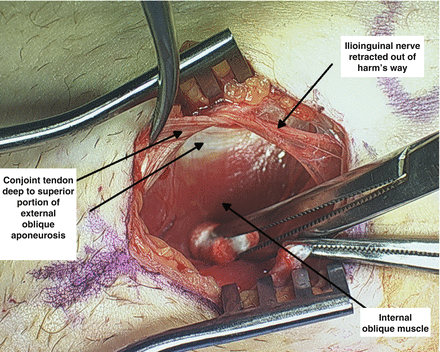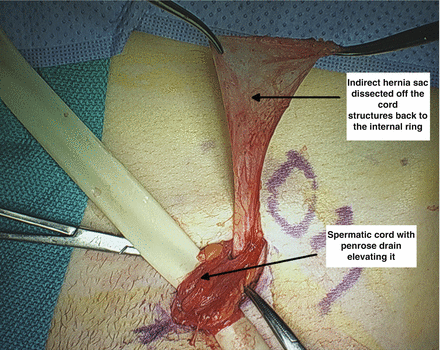Figure 30.1
Exposure for open repair of left inguinal hernia

Figure 30.2
Exposure of conjoint tendon
Dissect around the spermatic cord, and secure the cord with a penrose drain. Palpate the vas deferens within the cord. The vas feels like a piece of al dente spaghetti. This ensures that you have correctly isolated the spermatic cord. Incise the cremasteric muscle fibers longitudinally to expose the spermatic cord. If the patient has an indirect inguinal hernia, you will find it on the anteromedial surface of the cord. You may find a lipoma, a piece of preperitoneal fat protruding through the internal ring. If you find a lipoma, either reduce it through the ring or ligate and excise it. If you find an indirect hernia, dissect the sac off the cord structures all the way back to the internal ring (Fig. 30.3). You may incise (with care to avoid bowel injury, especially in the case of a sliding hernia) and explore the peritoneal sac. If you open the sac, place your index finger in the hole, palpate for the iliac artery, then palpate medially to search for a femoral hernia. If you find a femoral hernia you will have to modify your technique to repair it (briefly discussed later.) You can then perform a high ligation of the sac by clamping it off around the level of the internal ring (with care to ensure no bowel is present in the sac,) tying it off, and reducing the stump through the internal ring. Alternatively, you may reduce the sac without opening it. You would note a direct hernia as an attenuation and bulging of the transversalis fascia in the medial aspect of the inguinal area, in Hesselbach’s triangle, bordered inferiorly by the inguinal ligament, medially by the rectus muscle, and laterally by the inferior epigastric vessels.


Figure 30.3
Dissection of hernia sac off of spermatic cord
Repair the Hernia Defect
The surgeon performs a Bassini type primary repair by approximating the conjoint tendon with the inguinal ligament using interrupted permanent sutures, such as 2-0 polyester sutures. The Lichtenstein repair performs the same basic anatomic repair but uses mesh to bridge the gap to prevent the tension seen in the primary Bassini repair. Importantly, neither a Bassini nor a Lichtenstein operation will repair a femoral hernia defect, since the Bassini and Lichtenstein repairs cover the space anterior to the inguinal ligament, while a femoral hernia occurs deep to the inguinal ligament, anterior to Cooper’s ligament. To repair a femoral hernia defect, options include a McVay (Cooper’s ligament) repair (approximating the conjoint tendon to Cooper’s ligament), a primary or mesh plug closure of the femoral defect via an infrainguinal approach, or a laparoscopic repair.
Stay updated, free articles. Join our Telegram channel

Full access? Get Clinical Tree








